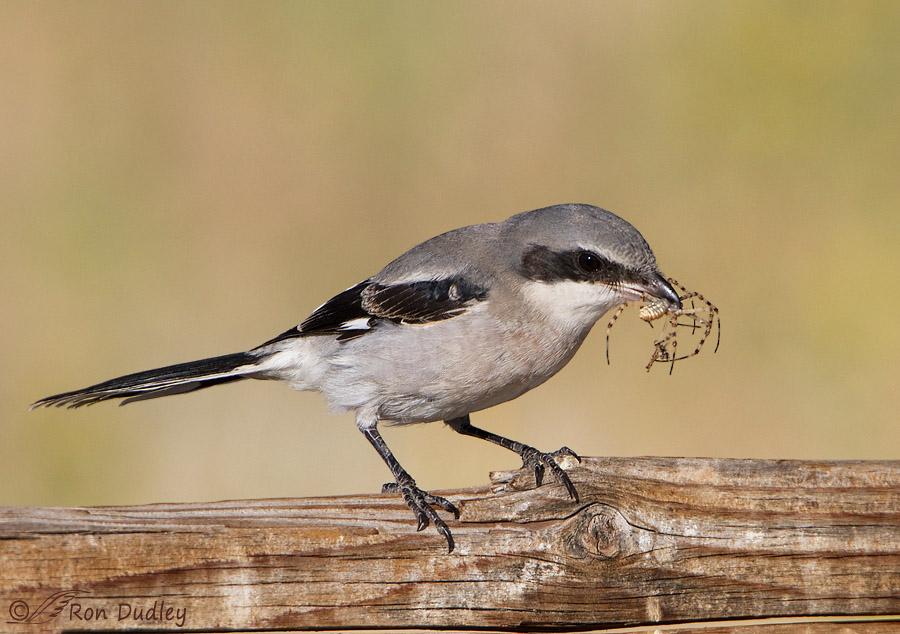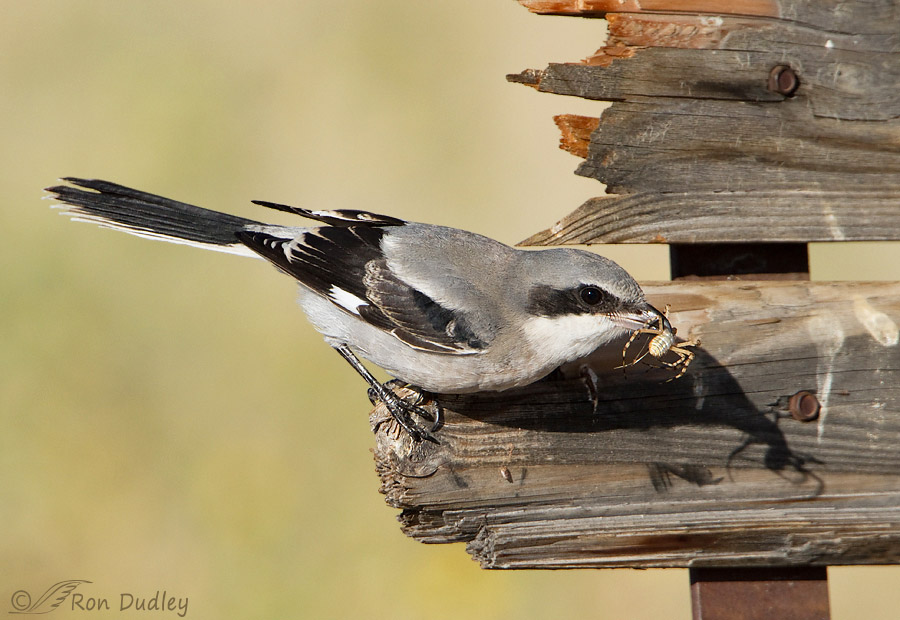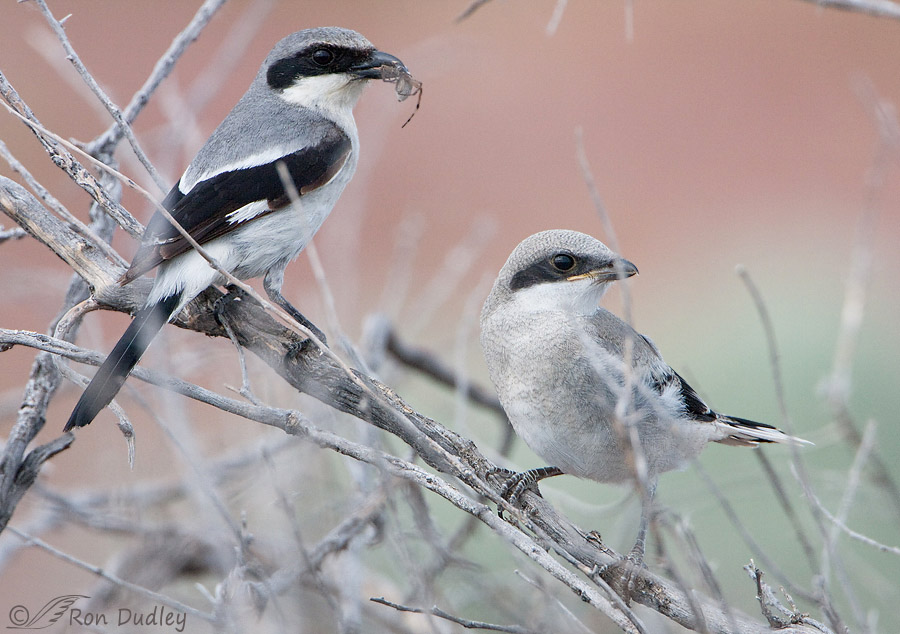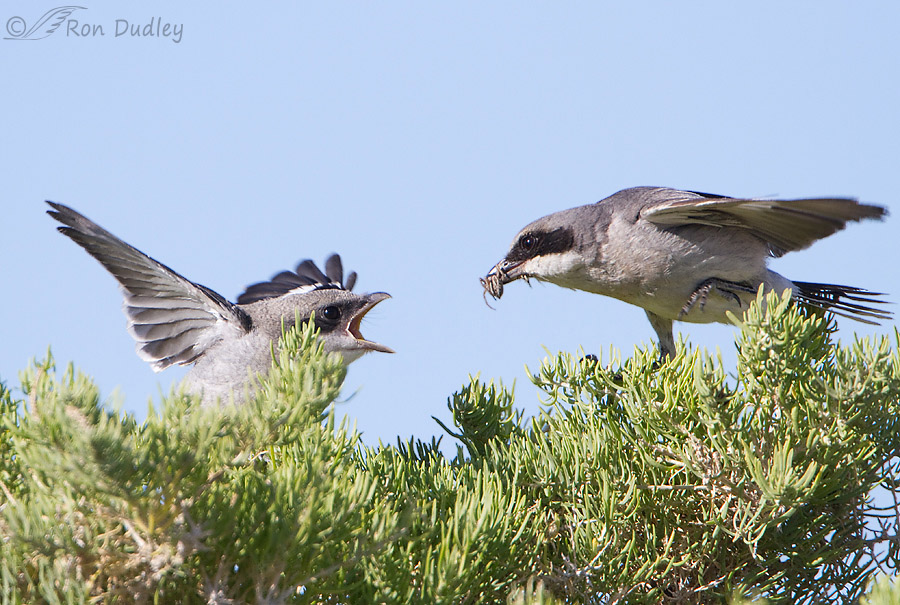And a memory jog from my friend Jaimi Butler.
Five days ago I received a request from Jaimi Butler, Coordinator of the Great Salt Lake Institute at Westminster College, to use some of my Loggerhead Shrike with spider images – particularly those where the adult shrikes are feeding spiders to their offspring. GSLI was involved in a long term research project studying the effects of mercury contaminants from industry as they move through the Great Salt Lake food chain, including the part of the chain that involves birds eating the abundant spiders on Antelope Island. They’re now creating a video on the subject for Antelope Island’s upcoming Spider Fest, thus Jami’s request to use my images which of course I allowed.
I hadn’t even seen those photos for years so I went back in my files and reviewed a few of them. I believe it’s been eight years since I posted some of them to my blog so I decided to feature a few of them again in an effort to inspire more participation of locals in this year’s Spider Fest (Covid Virtual Version) and to get more folks out to Antelope Island to enjoy the incredible explosion of spiders out there before they’re gone.

This time of year shrikes and other birds eat a lot of spiders on the island.

I’ve noticed that Shrikes are pretty careful about the way they handle spiders, usually grasping them by their head at least until they’re dead. They must instinctively understand the peril involved.

Here the adult on the left is about to feed a spider to one of its recently fledged offspring. Given the fondness of shrikes for cluttered habitats it’s difficult to get a clear shot of the feeding behavior.

Another spider about to contribute to the shrike biomass of the island. This time of year near the Great Salt Lake spiders seem to be the primary prey of shrikes, which makes perfect sense given their abundance.
So really, I encourage readers to visit Antelope Island this time of year if you can. Go in the early morning or in the evening when the light is at its best, the temperatures are cooler and birds and at least some other wildlife are most active. There’s lots of birds along the causeway just before you reach the island and spiders can be found everywhere in that area. When it’s this hot biting gnats aren’t a problem and the abundant brine flies don’t bite – they just contribute to the vast smorgasbord of the island. Pronghorn, bison and coyotes on the main part of the island are a mammalian bonus.
And don’t forget to watch the gulls as they run through the thick clouds of brine flies with their mouths open until they’re so full they can’t swallow another fly.
It’s really quite entertaining.
Ron
Addendum: Soon after I published this post this morning Jaimi made the following comment on Facebook which includes a link to the video they’re working on.
- “These images spurred a whole research project! Thanks for all that you do! The final video for the 2020 Virtual Spider Fest with an activity to discover what shrikes feed their young on Antelope Island can be found here: https://www.youtube.com/watch?v=oHWP3qp-RRw&t=15s (we are still working on the description in YouTube).”


I’m late with this group – WOW, great shots, and as usual great post!
Fantastic and educational photos! Thanks.
Thank you, Joanne.
Awe, wonder, delight.
Thank you – and the talented video team.
Spiders I am comfortable with (though the other household resident is NOT). Those brine shrimp though… That many of them at once would be too much for me. I am pretty sure that my vegetarian self would get a lot of animal protein as well.
I suspect you mean brine flies rather than brine shrimp, EC. We have oodles of both but the shrimp are no bother at all. Neither are the flies, really.
You are right I did. Please forgive my morning brain. And all those flying critters would bother me.
Jaimi, what a fabulous video and so cool to see Ron’s wonderful photography included. I can definitely see using this video quiz as part of an Ecology unit at multiple grade levels.
Ron, I imagine you’re tickled pink to have your photographs inspiring a research project and educating a whole new group of students. You can take the teacher out of the classroom… 😉
Yup, I’m tickled indeed, Marty. For several years I got great satisfaction out of seeing teams from GSLI out in the sagebrush on the island trapping shrikes and banding them for their research.
Interesting that spiders are a main food group for them, at least at that location and time.
Loggerhead Shrikes are virtually nonexistent here; plenty of spiders, though.
I’ll bet you have Northern Shrikes though, don’t you Lyle?
We do, only in winter and not often seen.
I just watched the video. THANK YOU ALL for producing and sharing it, but again the question, When will we (humans) ever learn?” SIGH 🙁
Echoing Laura. Loudly.
Don’t hold your breath, Laura.
What a glorious set of photos, and I had no idea about this activity, either the Spider Fest, the spiders or the birds that feed on them. Once again, I wish you’d been my biology teacher, but here we are and you are! The circle of life is REAL 😉
Unlike my mother who couldn’t even look at a spider without going into a conniption fit, I’ve never had a fear of them, have always welcomed them into my home and we’ve lived peacefully together. The black widows are still living in my garage and an unidentified black spider without markings is living right by the door. That said, I still turn into a ninja warrior if I walk through a spider web at night around my face. In the dark, you just never know what’s lurking and you really should listen to your survival instincts. LOL!
I saw a segment on Saturday morning kids’ TV based within the Henry Ford Museum where folks are working to use spider webs to make a much stronger fabric and/or adhesive–it’s been a while since I’ve seen that segment. I’ve slept since then, and occasionally soundly. Stuff falls out. I wonder if I put a cork in my ear I could stem the leak? 🙂
That’s right, Laura. Spider silk has incredibly high tensile strength so humans have been trying to come up with practical and useful applications for it for years.
Very nice, I will have to watch for the video. We usually participate in the Spider Fest. I was thinking of going out tomorrow. I love the spiders and the Franklin Gulls snapping at brine flies.
Do you mind if I share this blog via Facebook with a couple in Florida?
Sorry for the late response to your question, April. I spent most of the morning in a dentist’s chair having a complicated, unpleasant and expensive root canal done.
Sure, share away. No one ever has to ask for permission to share links to my posts. In fact I encourage it. It’s lifting images from my posts and sharing them that I have a huge problem with.
Cool! VBG! Great to see the images being used for educational purposes and to help the whole wildlife scene in the process! 🙂 “Web of Life” being shown big time! Well deserved Thx from them and ME for what you do…..
I appreciate that, Judy. The video is mostly meant for kids but I think they’re a very appropriate intended audience.
Best place to start and easy enough for adults to get drawn in and understand……. 😉
Interesting post, Ron. I love the sound the adult Shrikes make when they bring food to the nest- a Shrike dinner bell, if you will. Thanks for the link to the video. It’s a great reminder of how we all live downstream when it comes to environmental contaminants.
“It’s a great reminder of how we all live downstream when it comes to environmental contaminants”
Diane, that’s especially true for those of us who live near the Great Salt Lake. It’s a “dead lake” so everything that goes into the lake stays in the lake.
Good Point!
The spiders that I can see in your photos appear to be orb weavers,
guessing from their very long, striped legs–I’ve always thought them to
be quite beautiful–do they bite ? are they poisonous ? ( your caution about care )
Yes, they’re orb weavers, Kris. Most of them on the island are.
Spiders almost by definition are poisonous, to some degree and to some critters.
Interesting post with great photos. Who knew there was a Spider Fest! Spiders are just one of those things that I can do without…guess I have a touch of arachnophobia. 🙂
Kathy, it’s always a good idea to be careful with spiders. This time of year I never walk among the sage and rabbitbrush on the island because you become covered in spider silk and probably at least some spiders. It isn’t smart to take unnecessary chances with them.
But for many folks their fear of spiders is completely out of control and irrational (it doesn’t sound like you’re in that category). I just don’t understand it.
What an interesting and educational post. And of course excellent photos. I have taken many photos of Shrikes, but never eating anything. Had no idea they ate spiders. I forget the name for the fear of spiders, but I have one sister-in-law who I know could not even glance at these photos.
Arachnophobia, Everett. It’s incredibly common and incredibly irrational.
That’s it – thanks Ron